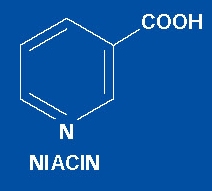Niacin & Niacinamide (B3)
Updated February 23, 2025
Vitamins
 Niacin, Vitamin B3, originally named “nicotinic acid” is a nutrient that goes back to the beginning of life. It plays a major role in genetics (via NAD, NADP and related molecules, brain function, cancer prevention, heart disease, and detoxification of fat-seeking toxins.
Niacin, Vitamin B3, originally named “nicotinic acid” is a nutrient that goes back to the beginning of life. It plays a major role in genetics (via NAD, NADP and related molecules, brain function, cancer prevention, heart disease, and detoxification of fat-seeking toxins.
While it requires finesse in its management, it is a magnificent anti-aging and anti-cancer agent. The RDA of 18 mg is way too low. Hoffer took 3,000 – 4,500 mg a day of niacin, but most people struggle even with 25 to 50 mg. Separately niacinamide can be taken at 500 mg twice a day which does not have the same scope as niacin but is proven to help with skin cancer (and possibly other cancers as well; click here for more)
Niacin’s Effects on Histamine and Prostaglandin-Related Conditions.ai.2025_02
Niacin Effective to Raise HDLs, Italian Scientists Reluctantly Concede in 2014
Though this article from Italy clearly panders to big pharmacy, the authors apparently have enough residual integrity to mention niacin favorably.
Niacin Flush Management
Niacin-Hoffer Interview
FYA: Chat GPT's opinion
You
How can one balance out the positive and negative reports about niacin to determine how much and when to take?
ChatGPT
To balance positive and negative reports about niacin and determine appropriate dosage and timing, one must consider scientific literature, individual health conditions, and consultation with a healthcare professional.
Factors to Consider:
Research-Based Information:
Examine peer-reviewed studies and clinical trials on niacin to understand its effects.
Consider both positive and negative findings to form a comprehensive view.
Individual Health Profile:
Assess personal health conditions, including cardiovascular health, cholesterol levels, and existing medications.
Individuals with specific health issues may benefit differently from niacin supplementation.
Dosage Recommendations:
Follow established dosage guidelines recommended by health organizations or medical professionals.
Avoid self-prescription and consult with a healthcare provider for personalized advice.
Timing of Administration:
Consider the specific form of niacin being used (immediate-release or extended-release).
Follow any specific instructions provided by healthcare professionals or on product labels.
Self-Critique:
While providing information on niacin, it’s crucial to acknowledge the limitations and potential risks associated with its use. Niacin supplementation may lead to side effects such as flushing, gastrointestinal issues, or liver toxicity at higher doses. Monitoring liver function and adjusting dosage accordingly is essential. Moreover, individual responses to niacin may vary, and caution is warranted for those with pre-existing medical conditions.
It’s important to note that the information provided here is based on general knowledge up to January 2022. For the latest updates or specific recommendations tailored to individual health, consulting with a healthcare professional is advised.
For further reference, you can explore scientific articles on niacin from reputable sources such as the National Institutes of Health (NIH) at nih.gov.
Always prioritize evidence-based information and seek guidance from healthcare professionals for personalized advice.
File Access
Dr. Hoffer's Supplements
External Links & References P2
Dietary-histone-deacetylases-HDACs-inhibitors-in-health-and-disease
Kynurenine-Pathway-Pathologies-CFS-FMS.2013
Here is a pathetic article from Harvard, 2019, that sites ancient articles and essentially says nothing:
Assessment of the Role of Niacin in Managing Cardiovascular Disease Outcomes.jama.2019




